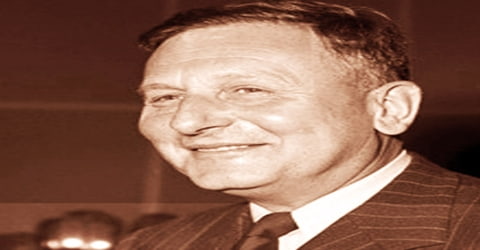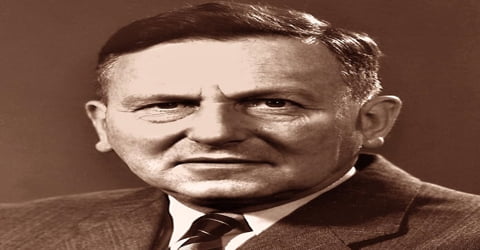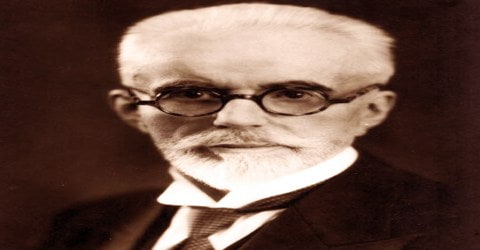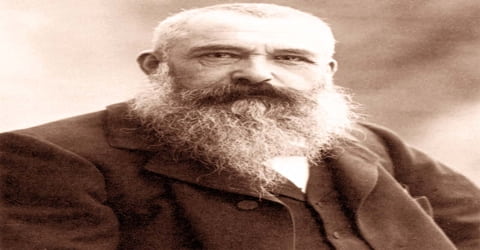Biography of Paul Hermann Müller
Paul Hermann Müller – Swiss chemist.
Name: Paul Hermann Müller
Date of Birth: 12 January 1899
Place of Birth: Olten, Solothurn, Switzerland
Date of Death: 12 October 1965 (aged 66)
Place of Death: Basel, Switzerland
Occupation: Chemist
Father: Gottlieb Müller
Mother: Fanny (née Leypoldt or Leypold) Müller
Spouse/Ex: Friedel Rüegsegger
Children: Heinrich (b. 1929), Niklaus (b. 1933), Margaretha (b. 1934)
Early Life

A Swiss chemist who received the Nobel Prize for Physiology or Medicine in 1948 for discovering the potent toxic effects on insects of DDT in the control of vector diseases such as malaria and yellow fever, Paul Hermann Müller was born on January 12, 1899 in Olten, Solothurn to Gottlieb and Fanny (née Leypoldt or Leypold) Müller. With its chemical derivatives, DDT became the most widely used insecticide for more than 20 years and was a major factor in increased world food production and the suppression of insect-borne diseases.
Though DDT had been available since 1873 it had to be ingested by the insects to be effective like all other insecticides till that time. This was an important discovery as DDT was used to kill mosquitoes carrying the malaria virus and helped save a large number of Allied soldiers fighting in the Far East. The shirts of the American and British troops were impregnated with DDT. The first large scale use of DDT was made in Naples, Italy, in 1943 to check a typhus epidemic which could be brought under control within three weeks of using the chemical. The biggest success of this chemical was its ability to reduce the incidence of malaria in different parts of the world by killing the mosquitoes that carried the germ. He developed substances for the tanning of leather that were synthetic in nature but produced fast colors. He also found out methods to conserve hides and to make wool and textile resistant to moths. His interest in botany also helped him discover a seed dressing which was free from mercury and helped the Swiss farmers.
Childhood, Family and Educational Life
Paul Hermann Müller, also known as Pauly Mueller, was born in Olten, Solothurn, Switzerland on January 12, 1899. His father, Gottlieb Muller, was an official of the Swiss Federal Railways and his mother was Fanny Leopold. He was the oldest of the four children in the Muller family. He spent most of his early childhood in Lenzburg, in Aargau, but had to move to Basel at the age of five when his father was transferred there.
After moving to Basel, Müller attended a primary school. He attended the ‘Freie Evangelische Volsschule’ (free Protestant peoples school) elementary and secondary schools later. In that time, he had a small laboratory where he could develop photographic plates or build radio equipment. In high school, Müller was only an average student. His grades suffered because he spent all his free time in his little home laboratory performing elementary experiments. In high school and college, Müller was often mocked by his peers being called, “The Ghost,” due to his thin and pale appearance.
In 1916 Müller left school to work as a laboratory assistant at Dreyfus (or Dreyfuss & Cie) and Company; the next year he became an assistant chemist in the Scientific-Industrial Laboratory of the electrical plant of Lonza A.G. Returning to school in 1918, he obtained his diploma by 1919 and entered Basel University in the same year. At Basel University he studied chemistry (with a minor in botany and physics) and started to study inorganic chemistry under Professor Friedrich Fichter.
In 1922 Müller changed his work to organic chemistry from inorganic chemistry. He received his PhD from the University in April 1925, for a thesis on the oxidation of ‘m-xylidine’ and its derivatives. He also studied physical chemistry and botany at the university.
Personal Life
Paul Hermann Müller married Friedel Rüegsegger in 1927 and had two sons, Heinrich (b. 1929) and Niklaus (b. 1933), and one daughter, Margaretha (b. 1934). His wife took charge of the household and raised their two sons and daughter so that Paul could concentrate on chemistry.
In his free time, Müller enjoyed the nature in the Swiss Alps and in the Swiss Jura where he owned a small holiday home, allowing Paul to resume his longtime interest in botany. Furthermore, he owned a small fruit farm that he regularly tended to. Müller often relaxed while gardening, photographing mountain wildflowers, and taking the children on early morning nature walks. Moreover, Paul and his wife, Friedel, often enjoyed playing flute and piano duets from Gluck’s Orfeo and Eurydice. Reading on the weekends in the mountains, Müller immersed himself in the science of plant protection and pest control. This fascination resulted in his research on pesticides at Geigy, and sequentially the discovery of DDT’s pesticidal properties.
Career and Works

On May 25, 1925, Paul Hermann Müller joined as a research chemist in the dye division of the firm ‘J. R. Geigy’ which produced synthetic dyes, plant-based dyes and tanning agents that were available in nature. He remained with this company for the rest of his life. In 1930 he developed synthetic tanning agents and dyes which remained fast under sunlight.
In 1935 Müller began his search for an “ideal” insecticide, one that would show rapid, potent toxicity for the greatest number of insect species but would cause little or no damage to plants and warm-blooded animals. He also required that it have a high degree of chemical stability, so that its effect would persist for long periods of time and its manufacture would be economical. Four years later Müller tested a substance known as dichlorodiphenyltrichloroethane (DDT) and found that it satisfied these requirements. The German chemist Othmar Zeidler had first synthesized the compound in 1874 but had failed to realize its value as an insecticide.
In 1937, Müller patented a technique for synthesizing novel rhodanide- and cyanate-based compounds which showed bactericide and insecticide activity. He then developed the product Garmin one, a seed disinfectant which was safer than the mercury-based disinfectants at the time.
In 1939 Müller developed DDT or ‘dichloro diphenyl trichloroethane’ which did not have much use since it was first discovered in 1873. Till that time all insecticides were either natural which was very expensive or synthetic which were ineffective. The effective insecticides available till then were Arsenic-based and were equally poisonous to humans, animals, and plants.
The compound he had placed in the cage was dichlorodiphenyltrichloroethane (DDT), or, more precisely, 1,1,1-trichloro-2,2-bis(4-chlorophenyl)ethane, which a Viennese pharmacologist named Othmar Zeidler had first synthesized in 1874. Zeidler, while publishing a paper about his synthesis, had not investigated the properties of the new compound, and had thus failed to recognize its extraordinary value as an insecticide. Müller quickly realized that DDT was the chemical he had been searching for. Tests of DDT by the Swiss government and the U.S. Department of Agriculture confirmed its effectiveness against the Colorado potato beetle. Further tests demonstrated its astonishing effectiveness against a wide range of pests, including the mosquito, louse, flea, and sandfly, which, respectively, spread malaria, typhus, the plague, and various tropical diseases.
Müller got a Swiss patent for it in 1940 and production of DDT was started by Geigy. He also got a British patent in 1942 and an American patent in 1943 after which the production of insecticide started in both the countries in real earnest. It was first tested on the Colorado potato beetle in 1943 by both the US and the Swiss governments with great success. It was successfully used to stop a typhus epidemic in Naples, Italy in 1943. Over the years the insecticide started showing signs of other toxicities harmful to animals and humans and its use was drastically reduced.
In January 1944 DDT was used to quash an outbreak of typhus carried by lice in Naples, the first time a winter typhus epidemic had been stopped. DDT saved the lives of millions during World War II. Between the 1950s and 1970s, DDT helped eradicate malaria entirely from many countries, the U.S. included.
Müller became Geigy’s Deputy Director of Scientific Research on Substances for Plant Protection in 1946. Although Müller had required his ideal insecticide to be relatively nontoxic to warm-blooded animals, the widespread use and persistence of DDT (in 1968 it was estimated that 1,000,000,000 pounds (453,000,000 kg) of the substance remained in the environment) made it a hazard to animal life, and it showed signs of disrupting ecological food chains. By 1970 DDT was rapidly being supplanted by more quickly degraded, less toxic agents; its use was banned in a number of countries.
In 1961 Müller retired from Geigy and carried out more experiments at the laboratory set up at his Oberswil home.
Awards and Honor
In 1948 Paul Hermann Müller was awarded the Nobel Prize in Physiology and Medicine, “for his discovery of the high efficiency of DDT as a contact poison against several arthropods.”
Müller was awarded an honorary doctorate by the University of Thessalonica in recognition of his discovery of the new form of DDT which was used effectively in the Mediterranean countries.
In 1963, Müller was invited to Greece and received with great sympathy and celebrated as a national hero.
Death and Legacy
Paul Hermann Müller died in the early morning of October 13, 1965, in Basel after a short illness surrounded by family and loved ones.
Paul Hermann Muller’s investigations in ‘Uber Konstitiution und Toxische Wirkung von naturlichen und neuen synthetischen insektentotenden Stoffen’ written with H. Martin and P. Lauger came out in ‘Helevetica chimica acta’ in 1944. His paper with the title ‘Uber Zusmmenhange zwischen Konstitution und insektizider Wirkung’ was published in 1946. He gave an account of the discovery of DDT in ‘Dichlorodiphenyltrichloroathan und neuere Inzekticide’ which was published in 1949.
Müller was regarded as an independent soul; a lone wolf. In fact, his daughter, Margaretha, called him an Eigenbrötler one “who makes his own bread.” He was determined and persistent in all aspects of his life, having learned a great deal from his college mentor, Professor Fichter.
Müller was instrumental in saving millions of lives by eradicating malaria from many countries and reducing its incidence in a big part of the world by discovering DDT.
Information Source:
















